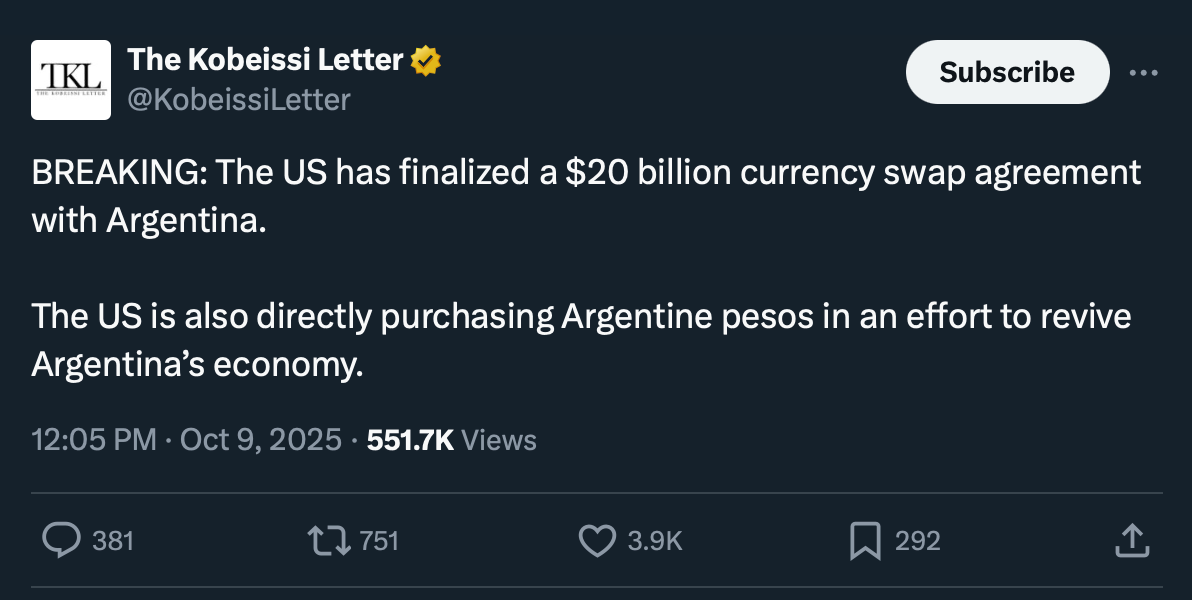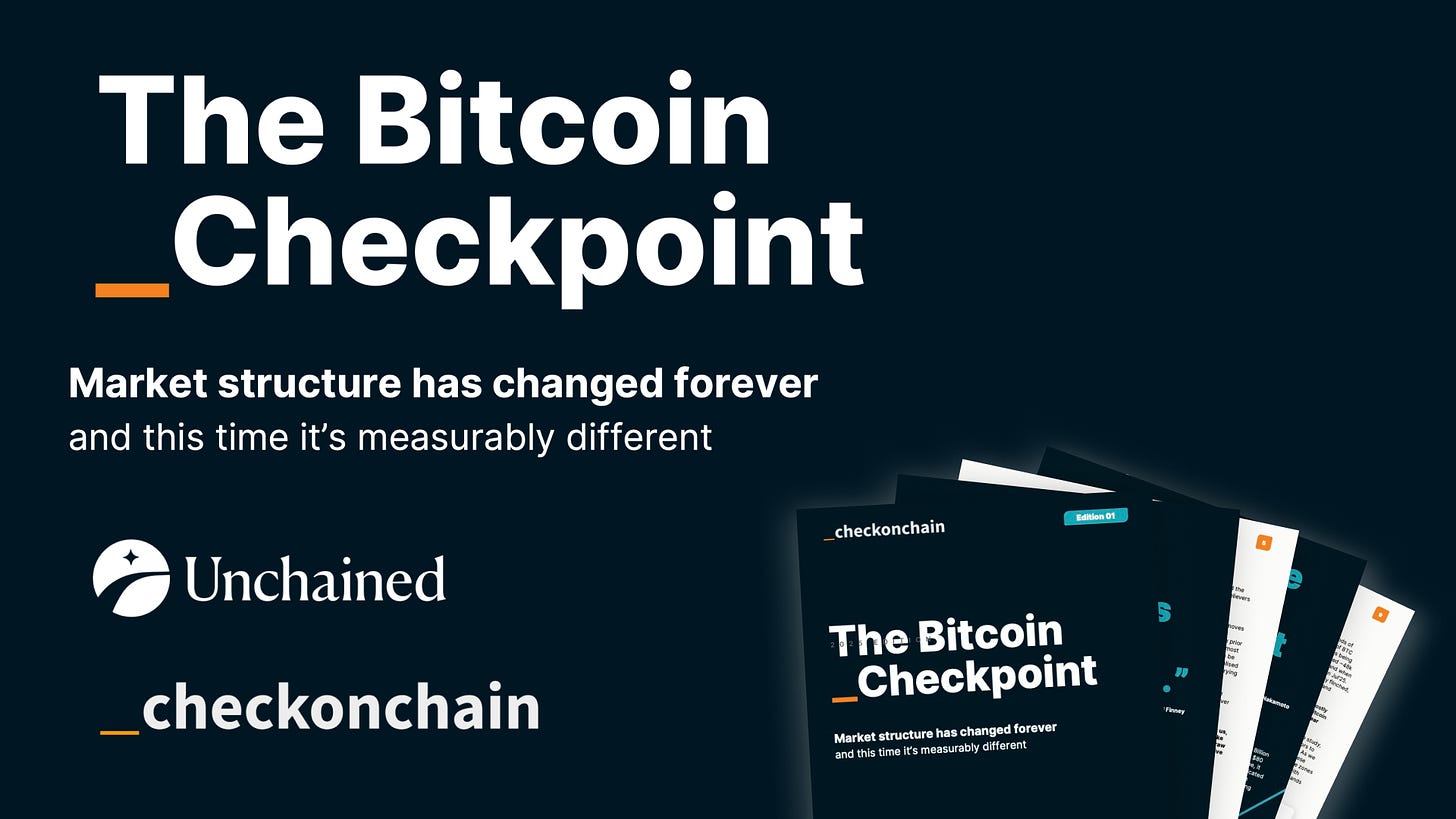💡 Why Did the US Treasury Just Rescue Argentina?
Issue 187
✌️ Welcome to the latest issue of The Informationist, the newsletter that makes you smarter in just a few minutes each week.
🙌 The Informationist takes one current event or complicated concept and simplifies it for you in bullet points and easy to understand text.
🫶 If this email was forwarded to you, then you have awesome friends, click below to join!
👉 And you can always check out the archives to read more of The Informationist.
Today’s Bullets:
What Are Currency Swaps?
Argentina’s Perfect Storm
Why (the heck) is the US Making This Bet?
The Bigger Picture: Truth About Fiat
Inspirational Tweet:
Well isn’t that interesting.
Amidst all the noise of China tariffs and leverage-driven crypto meltdowns this week, the US Treasury—not so quietly—performed another ‘rescue-like’ operation by extending a $20 billion lifeline to Argentina.
And not just any lifeline: the Treasury is actively buying Argentine pesos on the open market.
Let that register for a moment.
When was the last time you heard about the US Treasury stepping in to buy another country’s currency? If you can’t remember, that’s because it basically doesn’t happen.
Yet, here we are. Bessent, the former hedge fund manager who helped George Soros break the British pound in 1992, is now on the other side of the trade—defending a currency that most economists believe is overvalued.
I know $20 billion may sound like a pittance in the days of multi-trillion deficits. Heck, we sent ten times that amount to Ukraine.
That we know of, anyway. 🙄
But make no mistake. This act by the US Treasury was enormous.
But how exactly was it done, and why is it so important?
Both good questions, and ones we’ll answer—along with a number of others—nice and easy as always, here today.
So, pour yourself a big cup of coffee and settle into your favorite seat for a peek into the opaque world of Fed Swap Lines with this Sunday’s Informationist.
Partner spot
You know the story of bitcoin’s market cycles: euphoric blow-offs, brutal crashes. Maybe not anymore. The Bitcoin _Checkpoint takes a deep look at how the 2023–2025 cycle has rewritten market structure—and why these changes could be permanent.
Inside you’ll find analysis of record-low volatility, ETF flows absorbing billions monthly, and why long-term holders remain in control with $1.3T in unrealized profit. Plus, download now for automatic access to the event where James Check took a deep dive into the report himself.
💱 What Are Currency Swaps?
First things first, let’s cover the basics, because currency swaps aren’t something most people think about until a crisis hits.
A currency swap line is essentially an agreement between two central banks or treasuries to exchange currencies. It’s not a loan in the traditional sense—it’s more like a temporary currency exchange with a promise to reverse it later.
Here’s how it works in simple terms.
The US Treasury agrees to provide dollars to Argentina’s central bank.
In return, Argentina provides an equivalent value in pesos, using an agreed-upon exchange rate.
Argentina can then use those dollars to stabilize its financial markets, pay debts, or defend its currency.
When the swap matures, the currencies are exchanged back at the original rate.
Think of it like borrowing your neighbor’s Ford 150 King Ranch pickup truck. You give them your Fiat (see what I did there? 🤓), use the big pickup for a few weeks, then swap back.
Simple enough.
But the key detail here is the Exchange Stabilization Fund (ESF).
The ESF is a quiet little Treasury Department account created during the Great Depression.
Originally designed to stabilize the dollar, it’s since evolved to be used for all sorts of interventions—from supporting the Mexican peso in 1995 to providing emergency loans during the 2008 financial crisis.
Imagine that.
In any case, the ESF is funded by profits from past currency operations and holdings of something called Special Drawing Rights (SDRs).
Stay with me here.
An SDR is just a type of international reserve asset created by the International Monetary Fund.
Yes, that IMF.
SDRs are essentially a basket of major currencies (dollars, euros, yen, pounds, and yuan) that countries can use in times of crisis.
In Argentina’s case, Bessent has indicated that the Treasury might use SDRs from the ESF to help Buenos Aires pay down some of its massive debt to the IMF.
Why?
Because Argentina currently owes the Fund $55 billion—making it by far the IMF’s largest borrower.
A less than stellar creditor.
Now, here’s where this situation gets a bit spicy. 🌶️
Currency swap lines are typically used during global financial crises to prevent a meltdown in foreign exchange markets. The Fed opened swap lines with major central banks in 2008 to keep credit flowing. It did the same thing in March 2020 when COVID hit and the world scrambled for dollars.
But those interventions were multilateral—designed to stabilize the entire global financial system.
This Argentina deal is different.
It’s a bilateral intervention to support a single country with a troubled history.
And it gets even more interesting: the Treasury used Spain’s own Banco Santander to actually buy pesos on the market.
Why Santander?
Because of its strong presence in Latin America.
But make no mistake—this was a US government operation, not a private market transaction.
OK so, those are the mechanics. Now let’s talk about why Argentina so desperately needs this lifeline.
🌪️ Argentina’s Perfect Storm (Why They Need This Lifeline)
To really understand the current crisis, you need to understand what Javier Milei has been trying to do—and why it was working until it suddenly wasn’t.
See, when Milei took office as Argentina’s president, he inherited an economic disaster.
Inflation was running at nearly 300% annually, the government was drowning in debt, and the country was spiraling toward yet another default.
Milei’s solution? Take a chainsaw to the budget.
Literally.
That’s Milei campaigned with a chainsaw as a prop and promised to slash government spending, eliminate entire ministries, and bring Argentina’s finances under control.
And for a while, it actually worked.
Argentina posted its first budget surplus since 2009. Inflation fell from nearly 300% to around 30%.
Yay?
Financial markets loved it.
Investors piled into Argentinian trades. Bond prices rallied and the peso more or less stabilized.
For most of the past two years, betting on Argentina delivered healthy returns. Milei was being hailed as the reformer Argentina desperately needed.
But there was still a sneaky little problem lurking beneath the surface:
The peso.
Keep reading with a 7-day free trial
Subscribe to The Informationist to keep reading this post and get 7 days of free access to the full post archives.




